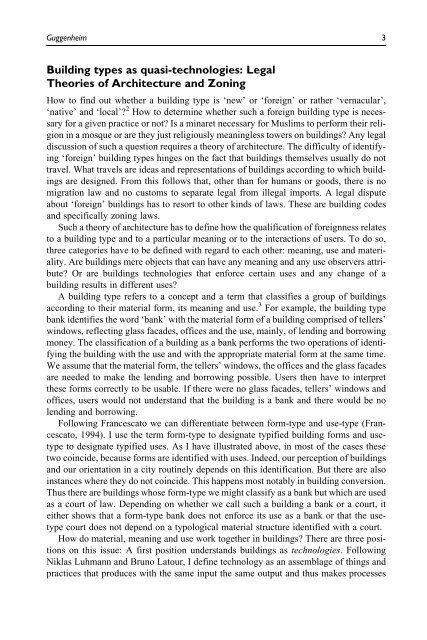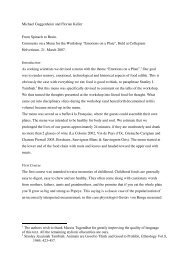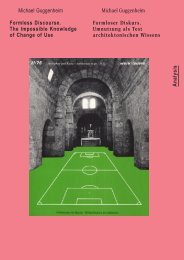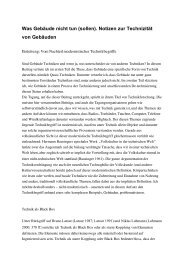The Laws of Foreign Buildings: Flat Roofs and Minarets - Michael ...
The Laws of Foreign Buildings: Flat Roofs and Minarets - Michael ...
The Laws of Foreign Buildings: Flat Roofs and Minarets - Michael ...
Create successful ePaper yourself
Turn your PDF publications into a flip-book with our unique Google optimized e-Paper software.
Guggenheim 3<br />
Building types as quasi-technologies: Legal<br />
<strong>The</strong>ories <strong>of</strong> Architecture <strong>and</strong> Zoning<br />
How to find out whether a building type is ‘new’ or ‘foreign’ or rather ‘vernacular’,<br />
‘native’ <strong>and</strong> ‘local’? 2 How to determine whether such a foreign building type is necessary<br />
for a given practice or not? Is a minaret necessary for Muslims to perform their religion<br />
in a mosque or are they just religiously meaningless towers on buildings? Any legal<br />
discussion <strong>of</strong> such a question requires a theory <strong>of</strong> architecture. <strong>The</strong> difficulty <strong>of</strong> identifying<br />
‘foreign’ building types hinges on the fact that buildings themselves usually do not<br />
travel. What travels are ideas <strong>and</strong> representations <strong>of</strong> buildings according to which buildings<br />
are designed. From this follows that, other than for humans or goods, there is no<br />
migration law <strong>and</strong> no customs to separate legal from illegal imports. A legal dispute<br />
about ‘foreign’ buildings has to resort to other kinds <strong>of</strong> laws. <strong>The</strong>se are building codes<br />
<strong>and</strong> specifically zoning laws.<br />
Such a theory <strong>of</strong> architecture has to define how the qualification <strong>of</strong> foreignness relates<br />
to a building type <strong>and</strong> to a particular meaning or to the interactions <strong>of</strong> users. To do so,<br />
three categories have to be defined with regard to each other: meaning, use <strong>and</strong> materiality.<br />
Are buildings mere objects that can have any meaning <strong>and</strong> any use observers attribute?<br />
Or are buildings technologies that enforce certain uses <strong>and</strong> any change <strong>of</strong> a<br />
building results in different uses?<br />
A building type refers to a concept <strong>and</strong> a term that classifies a group <strong>of</strong> buildings<br />
according to their material form, its meaning <strong>and</strong> use. 3 For example, the building type<br />
bank identifies the word ‘bank’ with the material form <strong>of</strong> a building comprised <strong>of</strong> tellers’<br />
windows, reflecting glass facades, <strong>of</strong>fices <strong>and</strong> the use, mainly, <strong>of</strong> lending <strong>and</strong> borrowing<br />
money. <strong>The</strong> classification <strong>of</strong> a building as a bank performs the two operations <strong>of</strong> identifying<br />
the building with the use <strong>and</strong> with the appropriate material form at the same time.<br />
We assume that the material form, the tellers’ windows, the <strong>of</strong>fices <strong>and</strong> the glass facades<br />
are needed to make the lending <strong>and</strong> borrowing possible. Users then have to interpret<br />
these forms correctly to be usable. If there were no glass facades, tellers’ windows <strong>and</strong><br />
<strong>of</strong>fices, users would not underst<strong>and</strong> that the building is a bank <strong>and</strong> there would be no<br />
lending <strong>and</strong> borrowing.<br />
Following Francescato we can differentiate between form-type <strong>and</strong> use-type (Francescato,<br />
1994). I use the term form-type to designate typified building forms <strong>and</strong> usetype<br />
to designate typified uses. As I have illustrated above, in most <strong>of</strong> the cases these<br />
two coincide, because forms are identified with uses. Indeed, our perception <strong>of</strong> buildings<br />
<strong>and</strong> our orientation in a city routinely depends on this identification. But there are also<br />
instances where they do not coincide. This happens most notably in building conversion.<br />
Thus there are buildings whose form-type we might classify as a bank but which are used<br />
as a court <strong>of</strong> law. Depending on whether we call such a building a bank or a court, it<br />
either shows that a form-type bank does not enforce its use as a bank or that the usetype<br />
court does not depend on a typological material structure identified with a court.<br />
How do material, meaning <strong>and</strong> use work together in buildings? <strong>The</strong>re are three positions<br />
on this issue: A first position underst<strong>and</strong>s buildings as technologies. Following<br />
Niklas Luhmann <strong>and</strong> Bruno Latour, I define technology as an assemblage <strong>of</strong> things <strong>and</strong><br />
practices that produces with the same input the same output <strong>and</strong> thus makes processes<br />
3







